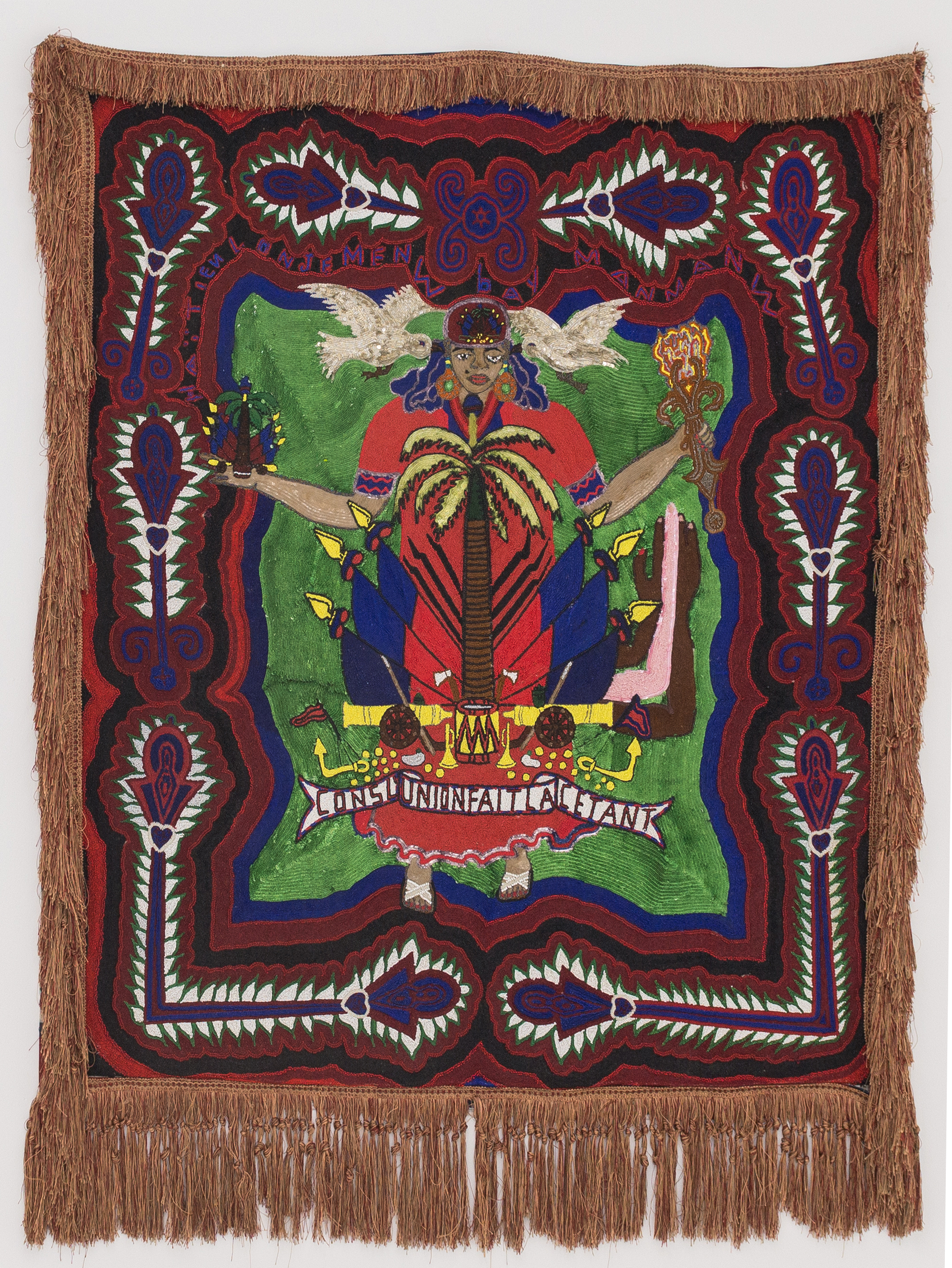MYRLANDE CONSTANT
Curated by Tomm El-Saieh
March 21 –April 20, 2018
Opening Wednesday, March 21 from 6-10 PM
Within the Vodou community the flag is a sacred ritual object that identifies the hounfour and honors the spirits with whom it is associated. The sparkle of the sequin or mirror used to capture the attention of the Iwa started in the temples. Drapo Voudou (sequined sacred flags) are unfurled at the beginning of a ceremony. They are power points that are used for both identification and transformation. When the flag is unfurled it signals the congregants to come to order—the sacred is about to come home to roost. The spirits will soon walk next to (or in) the market woman.[1]
Myrlande Constant works in her studio/home, which is located on top of a hill, surrounded by glass-less windows. This is, perhaps, the perfect setting for her flags, which undulate as the wind makes its way into the rooms.
Constant worked in a wedding dress factory with her mother. When her employers failed pay her for her labor, she left her job, taking bags with beads and her knowledge as severance pay. Using sewing and beading skills she learned at the factory (a French technique called tambour), Constant started working on her flags.
Consequently, in the early 1990s Myrlande Constant became the first woman in Haiti to apply the tambour technique to her work, which could be seen as a re-consideration of traditional Voudou flag making. Constructing flags (a masculine symbol) employing a feminine technique, charged her work with notions of gender.
In her works, Constant draws on the back of fabric stretched on wood, while the beading process, what would become the front of the flag, is being formed on the reverse side.
Myrlande works guided by her intuition. She works on the reverse side of the flag to both sketch a preliminary drawing and create her beaded compositions. She does not see the front side of the work until it is finished. An artwork that resembles a Voudou flag that isn’t seen until it is completed becomes an object worked on from the threshold of the visible. This is a symbol that signifies dualities, syncretism, a belief system, a religion, and a stand-in for those notions, all of which are developed, somehow, almost blindly.
Women, Columns, Names, and Flags
The saying ‘the Potomitan [2] is the woman, the mother, the courage of the family, that which supports the foundations of her universe” (“Le potomitan est la femme, la mère «courage» de famille qui supporte tel un pilier les fondements de son universe”) correlates women and the omnipresent column standing in a Voudou temple, considering them both as centers and connectors.
In Constant’s work, a type of connector or potomitan appears as a unifying element: her last name.
The name Constant, which is usually sewn in large and contrasting letters becomes a signifier that runs through various scenes as a constant presence, intervening the narratives of the Lwas [3]. Constant includes herself in her scenes, beading a self-portrait of sorts surrounded by her reality. This act of naming and charging her works with her last name brings into focus her viewpoint of Voudou ceremonies, offerings, narratives, and the Lwas’ roles as projections that live within our realm.
In one of her works, Constant presents naked women on top of horses—deities, riding, mounting people—or figures wearing sun glasses drinking from bottles next to skulls and penises. The ceremonial overlaps with the quotidian and time is addressed as a sum of temporalities while representations interact with each other, developing narratives where sexuality, politics and religion enter the space of naming and law. This is a law that is crossed by the subjective and is always defying temporal vectors, as it happens in magic. Furthermore, in what we call magic—this can also be applied to tradition—what remains unrealized or unfulfilled opens paths where one’s (constant) naming can update historical and personal truths, as well as non-academic but highly categorized types of knowledge, as is the case in Constant’s work.
Myrlande Constant’s praxis, therefore, presents knowledge and representations that address the space of the invisible, expanding the repertoire of faces given to the Lwas in Voudou. Hector Hyppolite was the first artist to give faces to the Lwas.
Andre Pierre followed up on the task. And now Constant is shaping and presenting their faces and actions from a woman’s perspective, working in Port-au-Prince, sewing blindly, from the reverse side of planes, extrapolating techniques to re-address institutionalized ways of approaching highly codified objects and signs.
Color, Anger, Prohibition
In Voudou, the Rada Lwas originated in Africa; they are generally considered benevolent and associated with the color white. The Petro Iwa appeared in Haiti, and in contrast, are aggressive and associated with the color red. The Ghede Lwa address death and carnality, perform dances, mimic sexual intercourse and behave irreverently; their color is black.
The Rada Lwas are traditionally associated with pre-slavery before the occupation of the symbolic by imperialistic domination. After the Haitian Revolution these deities developed a dark side, signaling anger and oppression or what appears to be another side of their roles. Those roles break through the religious space into the Real as unified totalities. This unification also signals syncretism’s embracing of Catholic saints and a merging with their African counterparts, as well as the political dynamics present in Haiti’s history. (Of note, as mentioned earlier, in Constant’s work, this merging is also evident in the its technical aspect: the beading process uses the French technique called tambourine, which is used for another type of ceremonial garment, the wedding dress, which in turn, re-defines ceremonial Voudou flags.)
Color in vodou is codified and the relationships established are clear: the dark side of Erzulie Freda is Erzulie Dantor, and cannot—or should not—share the same space with the white side of that Lwa. Their coexistence, although both form the same entity, could generate a type of friction in the realm of the symbolic, unleashing a clash, with repercussions, via the magical, into reality.
In Voudou, chromatic relationships carry within them functions and tasks. Each Lwa is invoked by a certain veve [4] , they are served certain offerings, shown specific colors, objects, food, chants and drumbeats. The veve, (a sign) used in a ceremony is dependent upon the Lwa whose presence is invoked. If an artwork has a veve in it, it could possess its owner. And if certain deities interact in an artwork, their colors should be considered thoroughly by the artist. Therefore a dual training is required when addressing Voudou in art: not only a formal training is needed, but also an initiation into the religion and its rules, which must be observed as they could impact reality directly, immediately.
In Constant’s work, moving beyond the traditional appearance of beaded flags and their roles, a questioning and an unleashing of traditional formats takes place. These operations emphasize a distancing from the didactic and the illustrative as her flags present encounters between mythical and contemporary issues such as earthquakes, a woman’s role, social upheaval, sexuality, etc. We should also note that due to the materiality of the work created with the tambour technique, Constant’s work is too stiff to be considered a flag, further separating it from traditional ceremonial flags.
Self-portraiture, blindness, flags, syncretism, sex, religion, names, etc., are all captured in Myrlande Constant’s flags, shining and moving in her studio. Hers is a praxis open to the outside, released through the feminine gaze from the male-dominated institutions that have instrumentalized naming, religion, art, labor, traditions and roles, constantly, until now.
Diego Singh, Haiti, 2015 - Miami, 2018
1 Josephson, Nancy, Spirits in Sequins: Voudou Flags of Haiti. pp. 15, Schiffer Books: 2007.
2 Lwas: they are the mysteries, or the invisible ones in Haitian Voudou. They act as links between god and humans. The Lwas are served respecting their culinary, chromatic and sacrificial preferences, and because of these set of specificities, they differ from saints, and can be understood as something else, as projections, or entities that act as shadows or amplifications. The Lwa were syncretized with the Catholic saints by the Fon and the Iwi, and in some cases Catholic saints have become loa, this is the case of John the Baptist.
3 Potomitan is a pole present in Voudou temples, placed in the center acting as a link between the realms.
4 Veve are signs used to address and invoke certain Lwas during Voudou ceremonies. A veve is usually drawn on the floor by strewing a powder-like substance, commonly cornmeal, wheat flour, bark, red brick powder, or gunpowder, and the material depends entirely upon the ritual. In Haitian vodou, a mixture of cornmeal and wood ash is used.









